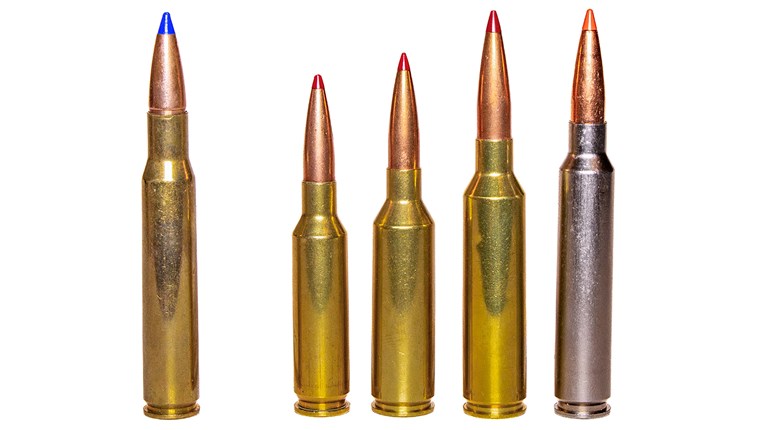
For the last half-decade, Hornady has led the industry with regard to long-range shooting. One could argue the company’s leadership actually began a dozen years ago with the introduction of the 6.5 Creedmoor. But, it wasn’t until after the release of the “American Sniper” movie in 2014 that the long-range-shooting movement really took off. Since then, other innovations from Hornady like ELD bullets, A-Tip bullets and the 6 mm Creedmoor and PRC cartridges, have put the company at the forefront of the current long-range trend. Hornady’s latest contribution to this shooting genre is the 6 mm ARC.
Hornady has a great working relationship with a specific (but unnamed) Department of Defense entity. Through that relationship, Hornady identified a need and a concept cartridge was discussed. This entity showed extreme interest, so Hornady started development. The result of that collaboration is the now-commercially available 6 mm ARC (Advanced Rifle Cartridge), which was adopted by that nameless unit about which we cannot speak.
Neophobia
Before we get into exactly what the 6 mm ARC is, I want to address those who suffer from neophobia—the fear of anything new. With every new cartridge, there’s a segment of the shooting public screaming things like, “It’s just so they can sell more guns and ammo,” or, “We don’t need new cartridges,” and my favorite, “It’s an answer to a question no one was asking.”
Let me begin by addressing the first claim. Of course, gun and ammunition manufacturers want to sell more guns and ammunition. They’re in the business of selling guns and ammunition. It’s how they make money, stay in business, continue to make more guns and ammunition and support pro-gun organizations like the National Rifle Association. So, yeah, you’re right. The thing is, you should be glad you’re right.
As for the other two, you might not need a new cartridge, but we get new cartridges because shooters ask for them. Without demand, there would be no supply, because yes, manufacturers need to make money. For example, since the AR-15 became the most popular rifle platform in the world, shooters have been trying to figure out how to “flatten the curve;” to make the .223 Rem./5.56 NATO shoot flatter. This resulted in faster twist barrels to stabilize higher BC (ballistic coefficient) bullets. It’s also why we have cartridges like the 22 Nosler, .224 Valkyrie, 6.5 Grendel and now the 6 mm ARC.
Maybe shooters were not asking for the 6 mm ARC specifically, but AR-15 shooters were damn sure looking for increased performance. Shooters expect innovative ammunition companies to, well, innovate. They want them to support their needs, and the 6 mm ARC is a direct result of new and unique products meeting demand.
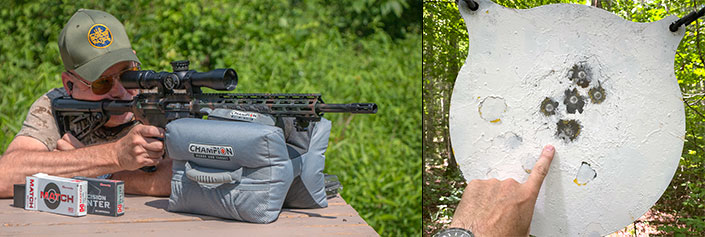
Physical Dimensions and Pressure
To better understand cartridges, we look at their pedigree to know where they came from. For example, the parent case for the .243 Win. (1955) was the .308 Win. (1952) and the parent case for the .224 Valkyrie (2017) was the 6.8 SPC (2002), which was derived from the .30 Rem. (1906). The 6 mm ARC’s lineage goes back to 1944 and the 7.62x39 mm, which was popularized by Mikhail Kalashnikov and the AK-47. The 7.62x39 mm cartridge case would ultimately spawn the .220 Russian (1950s), the 6.5 Grendel (2003) as well as an important wildcat cartridge.
While it might seem like the 6 mm ARC is a modified 6.5 Grendel cartridge, it appears what Hornady really did was standardize a common and popular wildcat—a non-SAAMI (Sporting Arms and Ammunition Manufacturers’ Institute)—cartridge known as the 6 mm PPC. The 6 mm PPC (Palmisano & Pindel Cartridge) was wildcatted in 1975 and has been very popular with benchrest competitors ever since. Its lineage can be traced back through the .220 Russian to the 7.62x39 mm.
No doubt, the 6.5 Grendel was inspiration for the 6 mm ARC project, and it could be argued the 6.5 Grendel is nothing more than a necked-up 6 mm PPC. It’s also important to note that there are multiple versions of the 6 mm PPC. If we look at SAAMI specifications, the information in the “Western Powders Handloading Guide,” and C.I.P. standards—Europe’s equivalent to SAAMI—case dimensions are quite similar between the 6 mm PPC, 6 mm ARC and 6.5 Grendel.
Of course, since bullet diameter is the primary distinguishing feature of any cartridge, this makes the 6 mm ARC a closer relative to the 6 mm PPC than any other cartridge. Case capacity of the 6 mm PPC is about 33 grains of water. Case capacity of the 6 mm ARC is 34 grains and 35 grains for the Grendel. The most critical difference is that in bolt-action rifles (from which the 6 mm PPC is typically fired) according to the “Western Powders Handloading Guide,” the 6 mm PPC is loaded to pressures approaching 60,000 psi.
For the purposes of slowing extraction and extending bolt life, Hornady set the maximum average operating pressure (MAP) of the 6 mm ARC at 52,000 psi. This is identical to the SAAMI MAP of the 6.5 Grendel, but 3,000 psi less than the .223 Rem. and .224 Valkyrie. Though this is not so much in step with the modern trend to push as much pressure as possible, in an effort to increase velocity and flatten trajectory, this makes perfect sense for military and civilian applications. Soldiers and civilians want their guns to last as long as possible. Less pressure equals less wear.
External Ballistics
Comparing the external ballistics of cartridges is a complicated endeavor. For example, between two identical rifle barrels you can see as much as a 100-fps difference with the exact same load. Additionally, when you begin to compare different cartridges of different calibers, with the vast array of available bullets from which to choose, apples-to-apples comparisons are impossible. For our purposes here, this comparison will use advertised velocities and ballistic coefficients that have been plugged into a ballistic calculator.
Let’s start with what I consider the primary difference that sets the 6 mm ARC apart from the flattest-shooting AR-15-compatible cartridges commercially available. When it comes to remaining supersonic with factory ammunition, about the best you can hope for with a .223 Rem. is 1,000 yards at sea level. The Valkyrie will fall below supersonic speed just short of 1,200 yards, and the 6.5 Grendel will make it out to around 1,125 yards. The 6 mm ARC will remain supersonic past 1,200 yards.
We could get into actual bullet drop at varying distances, but an easier window into trajectory is to look at time-of-flight. Using best loads and advertised velocities, the .223 Rem. will arrive at 1,200 yards in 2.36 seconds, the .224 Valkyrie in 2.15 seconds and the 6.5 Grendel in 2.26 seconds. By comparison, the 6 mm ARC gets there in 2.04 seconds. This means that during a 1,200-yard flight to the target, gravity and wind will pull and push on the 6 mm ARC between one- and three-tenths of a second less than its closest competitor. This makes the 6 mm ARC the flattest-shooting, commercially offered, AR-15 cartridge.
Testing
The advertised ballistics referenced are generally unreachable with factory rifles. This is mostly because advertised ballistics are usually based on test results from 24-inch barrels and are sometimes slightly inflated or at least rounded up. I obtained a Wilson Combat Super Sniper AR-15 with an 18-inch barrel to test the 6 mm ARC. I chose this rifle because I’m intimately familiar with Wilson Combat’s quality and performance. Its uppers and lowers are machined from a billet, the excellent barrels are made in house and the TTU trigger system is fantastic. Having worked with more than a half-dozen Wilson Combat AR-15-style rifles, I’ve yet to find one incapable of sub-MOA performance.
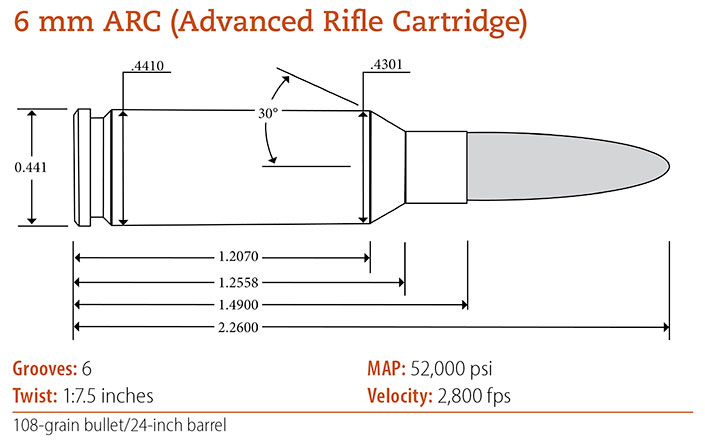
Hornady provided two loads: 108-grain ELD-Match and pre-production samples of 103-grain ELD-X Precision Hunter. Ten-shot strings with both loads were fired over a Caldwell G2 chronograph with the screens positioned 10 feet from the muzzle. The ELD Match load has an advertised velocity of 2,750 fps. Out of the 18-inch barreled Wilson Combat rifle it averaged 2,661 fps; 89 fps less than advertised. The ELD-X load averaged 2,711 fps. Hornady does not currently list a velocity for this load, but I’m guessing it will be about 2,800 fps, which works out to the same difference of 89 fps. This equates to a reasonable 14.8 fps loss in velocity, for each inch of barrel length, with both loads.
But, here’s the important part: Few shooters will build an AR-15 with a 24-inch barrel. However, even at the reduced velocities from the 18-inch barrel, the 6 mm ARC still remains supersonic past 1,200 yards, while also remaining superior to other commercial AR-15 cartridges with regard to bullet drop, time-of-flight and retained energy.
Did the 6 mm ARC deliver with regard to precision—such as the precision needed for 1,000-yard shooting? Well, what would you expect from a Wilson Combat AR and Hornady ELD ammunition? The ELD Match load averaged 1.046 inches for five, five-shot groups, and the ELD-X load averaged an astounding .693 inch. That’s approaching as good as I can consistently shoot with any rifle.
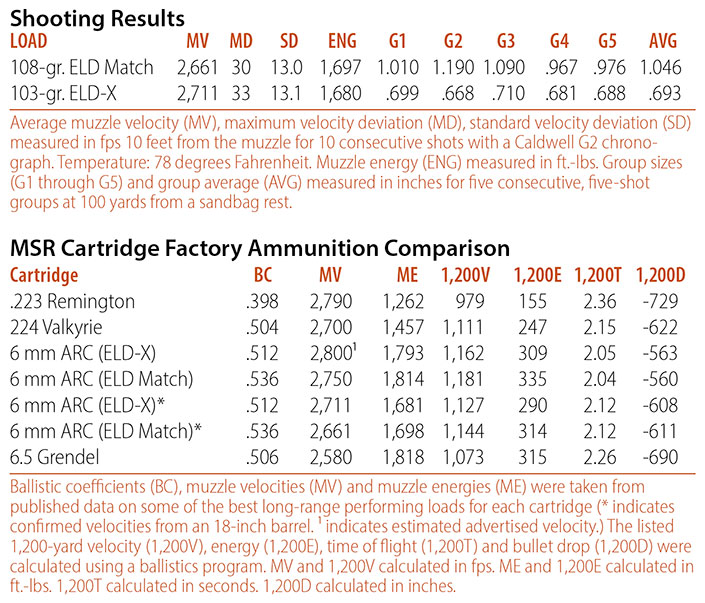
Availability and Application
So, the question the 6 mm ARC answers is, “What is the flattest-shooting AR-15 cartridge?” Sure, it’s really nothing more than a legitimized version of a cartridge that’s been around for almost half a century, but who cares? It now rules the roost when it comes to distance shooting with an AR-15. Will you be able to purchase rifles and ammunition? I’d think so; it’s too good for manufacturers to ignore. Hornady lists more than 20 manufacturers offering rifles, and with that much support, other ammo suppliers will have to get on board as well.
What’s it good for? That should be clear; it’s good for anything you might want to do with an AR-15, but it is ideally adapted to shooting at distance. For tactical applications and varmints inside 300 yards, the .223 Rem. probably remains the best option. The vast selection of purpose-built loads, combined with its higher magazine capacity, make it the undisputed king for those applications. At least for now, for varmint hunting at distance, the .224 Valkyrie has a bullet selection advantage, and for big game and some tactical applications at moderate ranges, so does the Grendel. But that’s likely to change in the 6 mm ARC’s favor.
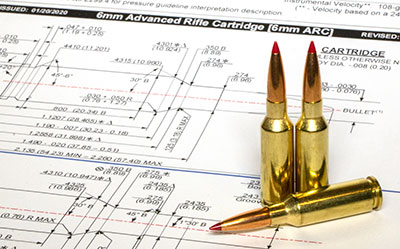
Distance is the forte of the 6 mm ARC. If you’re committed to the AR-15, once the range extends much past 500 yards, there’s currently no better option. I guess, since the 6 mm ARC flattens the curve, which, given that the cartridge was introduced in the middle of the COVID-19 pandemic, presents a degree of irony.
Will the 6 mm ARC manage to hang around for long? I’d say as long as folks are getting enjoyment from ringing steel and punching paper at least three football fields away, it will rise in popularity. Also, keep in mind, it is essentially a SAAMI-approved version of the 6 mm PPC, and that cartridge—which has set numerous benchrest records—has survived as a wildcat cartridge for a long time (with no manufacturing support). The 6 mm ARC may not be for you, but it has set a new standard for long-range performance from an AR-15. Any way you look at it, that’s a noble accomplishment. The real question is, why did it take us so long to adapt such a great cartridge to the MSR?
Sometimes, for something new, you just have to shine up something old.















